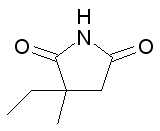A class of antiseizure drugs slows aging and increases life span in the roundworm Coenorhabditis elegans, researchers have found.
Because C. elegans has a naturally short life span--about 2 weeks, on average--scientists frequently use the species to explore aging. Previous studies have identified genetic modifications that can increase the worms' life span. However, few studies have examined whether drugs might have a life-extending effect as well, says Kerry Kornfeld of the Washington University School of Medicine in St. Louis.
He and his colleagues dosed separate groups of the worms with various types of drugs, ranging from diuretics to anti-depressants. Although most of the drugs had no effect or were toxic to the worms, Kornfeld's team found that ethosuximide, an anticonvulsant drug, increased the worms' life span by 17 percent.
A chemically related drug, trimethadione, extended the worms' lives by a whopping 47 percent, the team reports in the Jan. 14 Science.
The anticonvulsant drugs increased the worms' motility and stimulated egg laying, suggesting that the chemicals interact with C. elegans' nervous system. Kornfeld and his colleagues are now investigating whether the drugs deliver their life-extending effects by acting on still-to-be-discovered nerve cell processes that regulate aging.
Despite the boost in longevity that the anticonvulsant drugs yielded in worms, Kornfeld cautions that a similar effect has not been documented in people.
COPYRIGHT 2005 Science Service, Inc.
COPYRIGHT 2005 Gale Group



